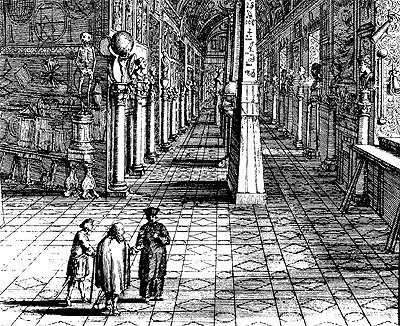
Athanasius Kircher was a 17th century Jesuit scholar, and studied, among other things, magnetism (both physical and personal), linguistics (with a specialty in hieroglyphics and cryptography), vulcanology (most notably via an expedition into Vesuvius), and the customs of exotic lands such as China and America. Many of the theoretical conclusions from his voluminous researches did not survive the test of time, so the results of his investigations are valued today more for their mythic and inventive qualities than their scientific accuracy. Kircher was also an inventor, and created, designed or improved animated fountains, magic lanterns, talking statues, and elaborate optical and musical instruments.
Kircher maintained a museum in Rome's Collegio Romano. The illustration above is from Giorgio de Sepibus's 1678 catalog of the museum. (click to see the full image). The museum contains the range of his interests: curiosities of nature, sculptures, Egyptian obelisks, and many of his mechanical marvels, all capped by a cosmic ceiling. Not shown in the images, but listed in the catalog, are a lizard encased in amber and a pair of creatures that were most likely the same species as the Zymoglyphic Museum's Jenny Haniver. The museum also included bound volumes of his correspondence, the 17th century equivalent of a curator's web log. His museum was really an extension of himself and went into decline soon after his death. The mechanical marvels stopped working and the more fanciful specimens disappeared. A catalog of the museum published in 1760, 80 years after his death, listed only antiquities.
I had not heard of him when I was younger, but I was afflicted with the same desire to know everything. I had a similarly wide range of interests: linguistics, cosmology, anthropology, biology. I ended up not going into science beacuse I could not specialize, and because science, broad as it was, still seemed too limited to physical reality, too literal, lacking in imagination. Perhaps creating a multi-faceted, personal museum has been the inevitable outcome.
The spirit of Father Kircher walks among us today in the form of the Secretary of the Athanasius Kircher Society. The society's Proceedings are daily writeups of the sorts of curiosities and esoterica that would have interested Kircher, and consistently the most interesting of the "oddities" blogs. The Proceedings have in the past year featured two of the Zymoglyphic Museum's collections, the Xenophora, shells that collect shells, and the miniature viewing stones. The Kircher Society recently has its first annual meeting in New York.
The Museum of Jurassic Technology in Los Angeles has an excellent exhibit on Kircher that reproduces many of his mechanical wonders.
The museum image above is from Stanford University's highly recommended Athanasius Kircher Project. Information about Kircher's museum is drawn from Paula Findlen's article "Science, History, and Erudition: Athanasius Kircher's Museum at the Collegio Romano" in The Great Art of Knowing: The Baroque Encyclopedia of Athanasius Kircher
No comments:
Post a Comment